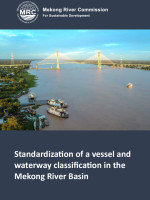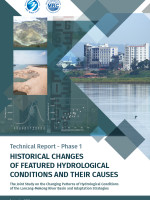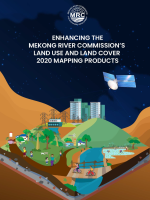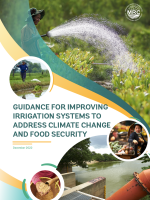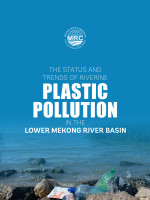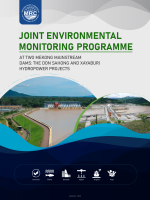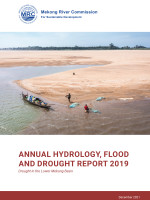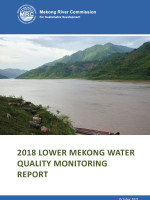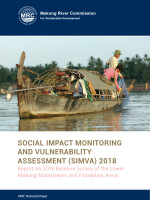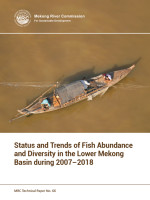Technical Paper Series
Development and update of water level and discharge rating curves for the Mekong mainstream
This technical note is an update of analysis of the rating curves for mainstream and tributaries of the Mekong River for 2009-2012, published in 2013, discussing the approach and methodology of rating curve establishment. The current publication underscores the Mekong River Commission Secretariat’s (MRCS) commitment to advancing integrated data management. The MRCS adopts the Time Series Management Software, AQUARIUS, to migrate rating curve development. This shift aims to establish a centralised, easily maintainable system, ensuring a reliable source of accurate water data. The transition of rating curve development to AQUARIUS is anticipated to enhance the efficiency, accuracy, and defensibility of water data management processes.
Download | DOI: 10.52107/mrc.bjv4xx | Published on: 20 Feb 2024 | Language: English
Standardization of a vessel and waterway classification in the Mekong River Basin
The "Standardize vessel and waterway classifications" is to update and harmonize different standards, rules, and regulations to uniform common standards for the development and liberalization of waterway transport on the Mekong River System. It involves analyzing technical and operational criteria for vessel classification and proposing standardized either one waterway classifications for the whole Mekong River Basin or two classifications for the upper and lower parts. It develops a proposal for waterway classification for each stretch of the Mekong River, its tributaries, and canals. In addition, a comprehensive set of regulations for vessel and waterway classification in the Mekong River Basin is prepared for implementation in the four MRC Member Countries.
Download | DOI: 10.52107/mrc.bgo9gq | Published on: 29 Dec 2023 | Language: English
Technical Report – Phase 1 of the Joint study on the Changing Patterns of Hydrological Conditions of the Lancang-Mekong River Basin and Adaptation Strategies
This is the 1st phase report of the Joint Study on the Changing Pattern of Hydrological Conditions of the Lancang-Mekong River Basin and Adaptation Strategies, conducted by the MRC and LMC Water Center. The report identifies two key factors that contribute to hydrological changes in the LMB. First are natural factors, including precipitation patterns, evaporation rates, soil properties and topography. Second are human activities, such as infrastructure development, water management, land cover and land-use changes. These two factors interact and influence the amount, timing and water distribution within the Basin.
Download | DOI: 10.52107/mrc.bd0zhw | Published on: 05 Oct 2023 | Language: English
Enhancing the MRC Land Use and Land Cover 2020 Mapping Products
This report summarizes the process starting from the background of the project, field data collection, and most importantly, the process of applying the Earth Observation technology via machine learning using the Google Earth Engine platform and the approach agreed by the expert group from the Member Countries to update the land cover and land use map of 2020 for the Lower Mekong Basin region.
Download | DOI: 10.52107/mrc.aqrsbr | Published on: 08 Jun 2023 | Language: English
Guidance for Improving Irrigation Systems to Address Climate Change and Food Security
This guidance gives a preliminary guidance for applicable irrigation techniques and technologies in the Lower Mekong Basin (LMB). This guidance was developed for the MRC Member Countries to use for mitigating impacts of climate change and natural disasters, addressing problems in irrigation sector, and improving irrigation systems in the LMB. This guidance also indicates the defects of irrigation techniques and technologies being utilized in the LMB and suggests where improvements could be made for better utilization.
Download | DOI: 10.52107/mrc.ajutos | Published on: 21 Dec 2022 | Language: English
The status and trends of riverine plastic pollution in the Lower Mekong River Basin
This report explains the status and trends of plastic waste pollution in the Lower Mekong River Basin from the perspectives of plastic pollution itself as well as the frameworks and capacity of each Member Country to address the issues of plastic pollution. The report estimates that in 2020, its four countries had produced about 8 million tons of plastic waste – of which, some 70% to 90% were plastic bottles, plastic bags and Styrofoam. Yet this debris does more than adversely affect the Mekong and its tributaries.
Download | DOI: 10.52107/mrc.aqrsb2 | Published on: 19 Dec 2022 | Language: English
Joint Environmental Monitoring Programme at Two Mekong Mainstream Dams: The Don Sahong and Xayaburi Hydropower Projects
The report provides an overview of activities conducted and resulting recommendations from monitoring two mainstream dams: Don Sahong and Xayaburi hydropower projects. It summarizes the pilot monitoring results from the first pilot site report for each hydropower project and the Combined Annual Report in a way that illustrates how findings in hydrology, sediment, water quality, aquatic ecology, and fisheries can be interpreted together. Based on the findings, it provides some initial suggestions for mitigation and adaptive management of construction and operation of hydropower projects. It also concludes with recommendations for revisions to the guidelines and monitoring protocols that can then be incorporated into the JEM Programme document.
Download | DOI: 10.52107/mrc.aqrs7o | Published on: 19 Aug 2022 | Language: English
Annual Mekong Hydrology, Flood and Drought Report 2019: Drought in the Lower Mekong Basin
This paper reports on the condition of the Basin in 2019, including its hydrology/water flow, flood and drought. The year saw recorded unprecedented flow conditions in the Mekong mainstream and from tributaries. Erratic climatic fluctuations were also found, ranging from extreme dry to extreme wet within short periods of time. The report ends with key recommendations, looking forward.
Download | DOI: 10.52107/mrc.ajutoy | Published on: 27 Dec 2021 | Language: English
2018 Lower Mekong Water Quality Monitoring Report
This reports on the results of the monitoring of water quality across 48 stations in the LMB. The report shows the water quality in the Mekong and Bassac Rivers was still of good quality with the slight improvement compared with 2016. There was only a small number of measurements of chemical oxygen demand (COD) and dissolved oxygen (DO) that violated the MRC Water Quality Guidelines for the Protection of Human Health (WQGH) and the MRC Water Quality Guidelines for the Protection of Aquatic Life (WQGA). Most exceedances were recorded in the Delta. Of a slight concern was the DO level at Chau Doc, which violated the WQGH for all sampling occasions causing water quality for the protection of human health to be downgraded from ‘good’ in 2017 to ‘moderate’ in 2018.
Download | DOI: 10.52107/mrc.qx5ynz | Published on: 19 Nov 2021 | Language: English
Social Impact Monitoring and Vulnerability Assessment (SIMVA) 2018
Report on 2018 baseline survey of the Lower Mekong mainstream and floodplain areas
SIMVA 2018 is the third survey of its type and was conducted in the same sites and used the same methods of collecting primary household and village data, as the SIMVA 2014 and 2011 exercises. Covering 2,800 households in 200 villages the 2018 survey shows that communities in the Mekong mainstream corridor were still dependent on the river resources for their livelihoods, income, and well-being. As such, they are still vulnerable to changes in the Mekong water resources. However, their overall dependency has decreased with other, non-water resources-related livelihood activities playing increasingly important roles. From 2014 to 2018 the percentage of households engaging in fishing decreased across the region from 50% to approximately 37%. The study also indicates growing incidence of flooding, possibly as a result of climate change and other factors, including water infrastructure development. Government support in livelihood diversification and disaster coping strategies is essential and there is much room for improvement in this regard.
Download | DOI: 10.52107/mrc.qx5ynt | Published on: 18 Oct 2021 | Language: English
Status and Trends of Fish Abundance and Diversity in the Lower Mekong Basin during 2007–2018
The report is the first ever large-scale study to consider both spatial and temporal variations of fish abundance and diversity in the LMB, using the MRC’s long-term fisheries monitoring data. The monitoring was conducted daily between 2007 and 2018 by professional fishers at 38 stations along the Mekong mainstream and its major tributaries. But only 25 sites were selected for the study due to incomplete data. Eleven of the 25 monitoring stations were in Cambodia, four in Lao PDR, and five each in Thailand and Viet Nam. The study found 617 fish species, belonging to 21 order and 80 families in the LMB from 2007 to 2018. Some 37,530,460 individuals, corresponding to 1,095,848 Kg of fishes were collected. Temporally, both fish diversity and catch have increased during the survey period in the Tonle Sap and the Mekong upstream in southern Laos and Thailand, informing the high diversity of these areas and that sampling effort is still growing.
Download | DOI: 10.52107/mrc.qx5yo0 | Published on: 18 Oct 2021 | Language: English
Technical Review Report on Prior Consultation for the Luang Prabang Hydropower Project
The report was prepared to support the prior consultation process for the proposed Luang Prabang hydropower project. It provides a scientific review of the documentation submitted to the MRC by the Lao National Mekong Committee, covering hydrology and hydraulics, sediment and geomorphology, water quality and aquatic ecology, fish passage and fisheries, navigation, dam safety, and socio-economic aspects.
Download | DOI: 10.52107/mrc.ajg3u2 | Published on: 14 Jul 2020 | Language: English

